Ah, there’s nothing more delightful than the smell of fresh-brewed coffee, is there? And after enjoying your morning cup of joe, it makes perfect sense to use the spent grounds in your garden.
Right?
For a well-intentioned gardener, repurposing the remains of our morning pick-me-up in the garden seems like a win-win! After all, java grounds are a great natural fertilizer.
Right?
And you can use these dregs to acidify the soil around crops like blueberries and strawberries.
Right… ?
My friends, it’s quite possible that we gardeners have some mistaken ideas about the nature of used coffee grounds and how we can best repurpose them in our gardens.

We link to vendors to help you find relevant products. If you buy from one of our links, we may earn a commission.
In this article, we’re going to look at some of the ways used java beans are currently being touted for garden use.
I’m going to let you know what the research has shown about these garden uses so you can decide for yourself whether each of these applications seems like a great idea – or a bad one.
Grab your mug and we’ll be on our way! Here’s what we’ll cover:
What You’ll Learn
The Contents of Spent Coffee Grounds
Before we get into the details of the best and worst horticultural uses for spent coffee grounds, let’s have a look at what exactly these dregs contain that may be of interest in our gardening pursuits.
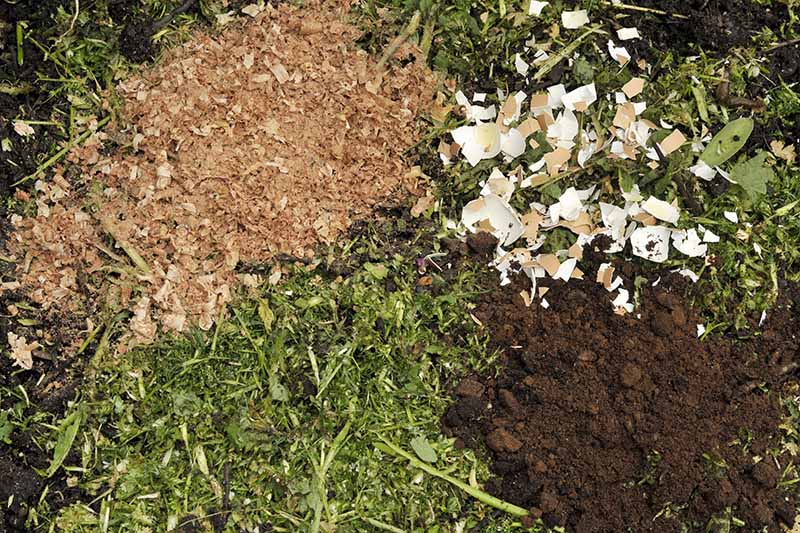
One thing that gardeners are often hoping for in reusing this food waste is nitrogen, a macronutrient essential for fueling the soil food web and for producing lush, healthy plants.
Your used java beans do indeed contain this essential element – they are composed of approximately two percent nitrogen.
And they also contain small amounts of the minerals and plant macronutrients phosphorus and potassium.
For gardeners used to sourcing fertilizer from boxes and bags, let’s put that into familiar terms. Coffee dregs have an NPK ratio of 2.0-0.3-0.2, according to the authors of the North Carolina State University Gardener Handbook.
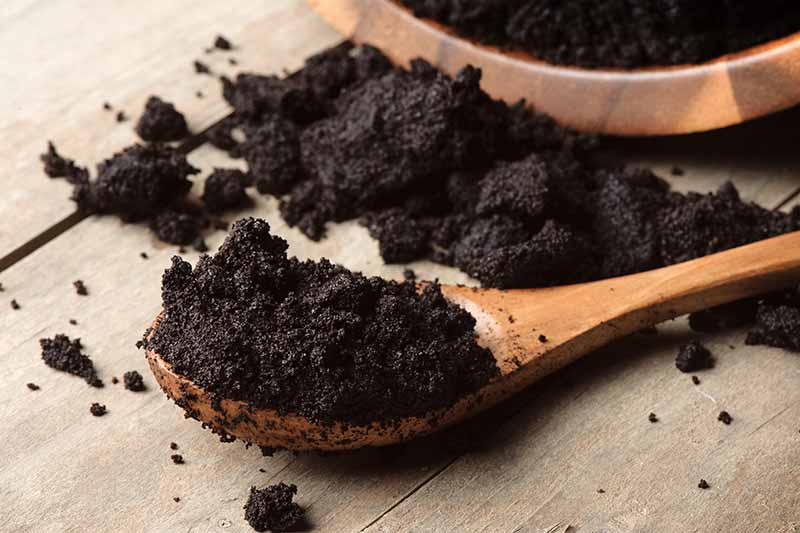
This is a similar ratio to that of blood meal, a fertilizer that is used for heavy feeders such as corn and broccoli.
In addition to phosphorus and potassium, used coffee grounds also contain small amounts of other minerals, including calcium and magnesium.
Adding minerals to your soil may or may not be beneficial, depending on what type of soil you have and what you intend to grow.
If you’d like to know more about the mineral content of your soil, consider performing a soil test so that your soil improvement efforts rest on a solid foundation of knowledge.
Now that we’ve talked about nitrogen content in terms of fertilizing, let’s talk about it in terms of composting.
Java dregs contain nitrogen and carbon at a ratio of approximately 1:20. That’s not too far away from the recommended nitrogen to carbon ratio of a healthy compost heap, which is 1:30.
So, when it serves as an ingredient to add to your compost heap, the residue from your morning brew can be considered primarily as a source of carbon.

As far as pH goes, you may have heard that used java grounds are on the acidic side. Unfortunately for those of us hoping for an easy way to acidify the ground around our blueberry bushes or strawberry plants, that’s not necessarily the case.
First of all, since the acid in your morning joe is water soluble, much of the acid from the brew goes into your cup rather than staying bound to the used grounds.
And according to Jeff Schalau, Extension Agent and Agriculture and Natural Resources Director at the University of Arizona Cooperative Extension, spent coffee grounds are not consistently acidic – depending on the sample, their pH can range from acidic to slightly alkaline.
What’s more, the pH value of these dregs can change over time. Even if they are acidic when you apply them, they won’t necessarily remain acidic as they break down.
What does that mean? Plain and simple: java dregs are not a reliable method of acidifying the soil.

This news may come as a surprise, or a big disappointment. However, there are other options for lowering soil pH, including the use of elemental sulfur.
Another method of balancing soil pH is to incorporate compost into your growing area. If you’d like to produce your own homegrown supply of this soil amendment, you can learn how to create a compost pile of your own by reading our article.
And yet another, less-work-intensive approach to dealing with pH problems would be to grow the plants that are by nature better-suited to your unamended soil, such as adapted or native plants.
To gain a greater understanding about your garden soil, including soil pH, make sure to read our article.
And there is one other component of java dregs that many of us gardeners may be overlooking.
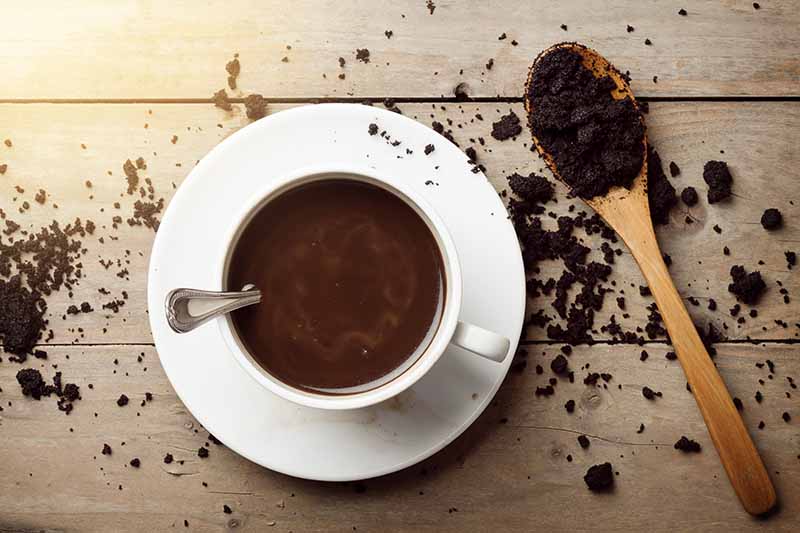
Coffee, as if you could have possibly forgotten, contains caffeine.
When you prepare your French press, espresso, or latte, you might think (and hope!) that all of that energy-inducing caffeine goes straight into your cup.
Alas, that’s not the case.
The authors of a study published in Trends in Food Science and Technology in September 2015 found that up to 48 percent of the caffeine from used java beans remains in the dregs.
Before you start to wander off into a daydream where this caffeine boost helps your imagined garden to grow really fast, let’s take a moment to examine what the purpose of caffeine is in the first place, not for us, but for the plant that produces these miraculous beans.
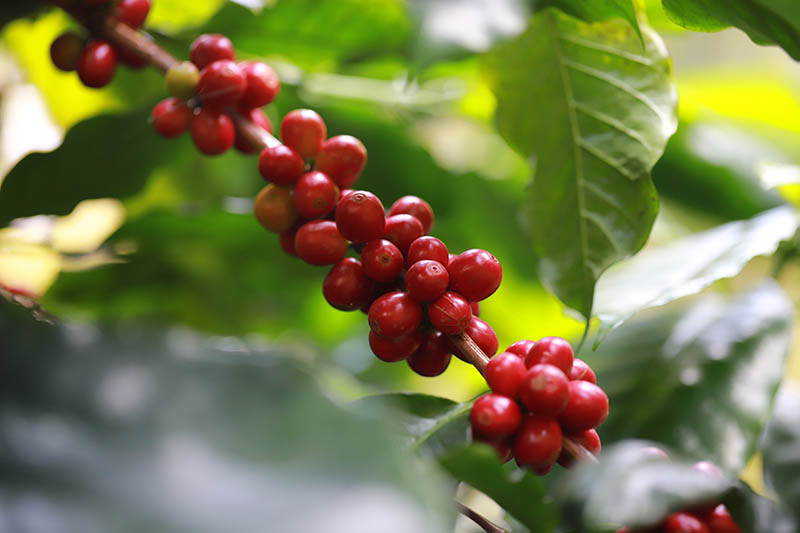
As are most of the plant-derived drugs we use, caffeine is created by plants such as Coffea arabica as a defense mechanism.
Caffeine helps to protect certain Coffea species from the hungry mouths of herbivores, acting essentially as a natural pesticide.
An alkaloid, like many other plant toxins, caffeine also helps to prevent competition from other plants – so it’s also an herbicide of sorts.
But that’s not all! Caffeine is also an antimicrobial, capable of killing bacteria, and an antifungal that has been used to help fight unpleasant fungal infections of the human gut, such as Candida albicans.
As you can imagine, these biocidal tendencies might cause some issues in the garden!
But don’t throw the contents of your filter in the landfill trash just yet. This doesn’t mean you can’t use spent grounds at all, it just means you’ll want to be very selective in your use.
For those attempting to garden as organically as possible, you might wonder if coffee dregs contain unwanted pesticide residues.
Perhaps your own java purchases tend to run along the fair trade and organically grown side of things. But when you see bags of free (but not necessarily organic) used grounds from your local cafe, should you grab them up?

The data on this point is reassuring.
It seems that many pesticides are greatly reduced or eliminated during the roasting process, before you even prepare your brew, resulting in both tasty cappuccinos and spent grounds that contain minimal or zero detectable pesticide residues.
Gardening Uses for Spent Coffee Grounds
Now that we’ve gained a better understanding of the contents of our coffee dregs, let’s look at what the research says on using this food waste product in various gardening applications.
As a Soil Amendment
Coffee dregs look so dark and rich – they practically look like soil! So, it might be tempting to sprinkle them directly onto your planting beds.
But before you go scattering your spent grounds around on your garden soil, remember what we learned about caffeine’s ability to discourage the growth of plants?
Experts at the Oregon State University Extension Service tested this out with an experiment. They planted lettuce seeds, then added uncomposted spent coffee grounds to the soil as an amendment.
The not-so-unexpected results of this experiment were that the dregs stunted the growth of the lettuce seedlings.
Similar results were obtained in other studies as well, such as one described in the August 2016 issue of Urban Forestry and Urban Greening.
The authors of this study found that used coffee grounds greatly reduced plant growth of broccoli, leeks, radishes, violas, and sunflowers.
Are you wondering if decaf would be safe to use in place of fully caffeinated dregs? While the caffeine content is reduced in decaf, the resulting beans are not entirely caffeine free.
Using decaf grounds as a soil amendment would mean you’d still be serving up an unknown dose of caffeine.
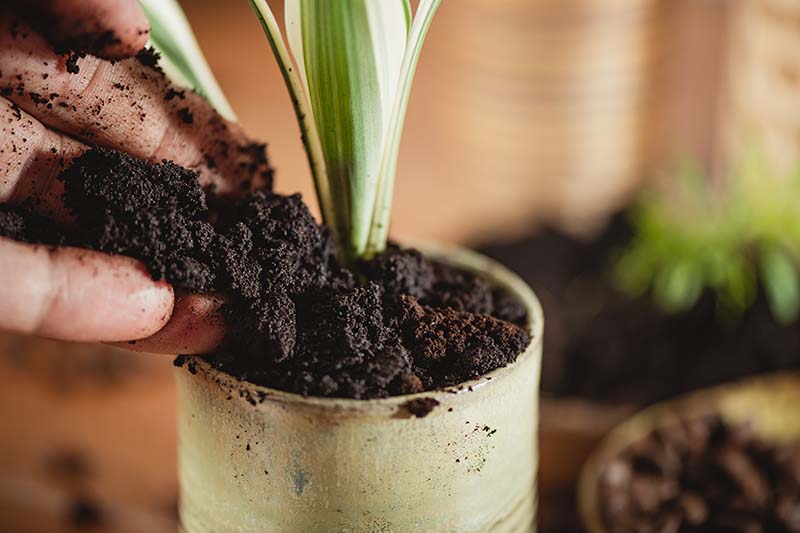
And if caffeine can stunt the growth of the plants in your veggie garden, it has the potential to do the same to your houseplants too.
I don’t know about you, but personally, I’m saying “thanks but no thanks” to this particular use.
In Vermicompost
Now that we’ve seen that the caffeine in java grounds can be detrimental to plants, it’s time to have a look at how it affects animals, notably earthworms.
Whether it’s the earthworms in your garden soil or in your vermicompost bins, caffeine can be toxic to them as well.
A study published in the September 2011 issue of Bioresource Technology described testing earthworm survival and growth rates in three different composting systems where spent coffee grounds were added.
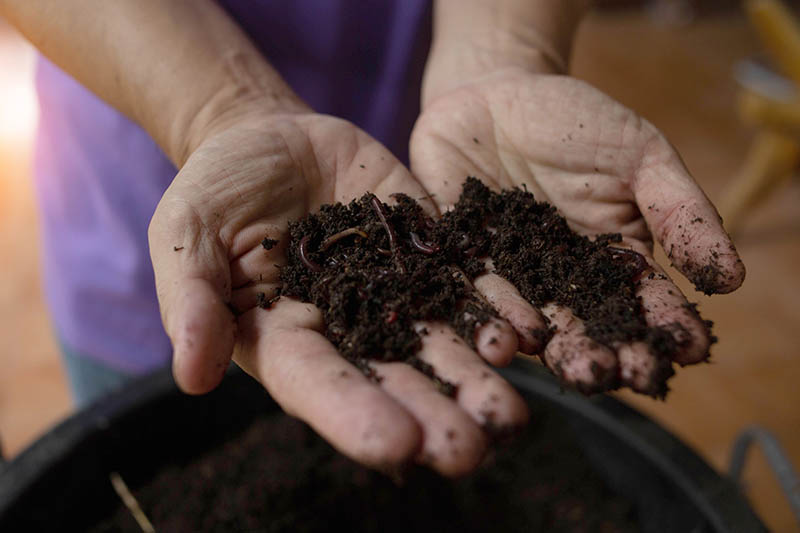
The authors of the study concluded that in all three composting systems, java dregs stunted earthworm growth and increased mortality rates.
However, mortality rates were lower if cardboard was included in the mix – thanks to its higher carbon content, which helped to buffer chemical exposure to the earthworms.
While caffeine seems to have a negative effect on earthworms in vermicomposting systems overall, that doesn’t mean this method of breaking down the dregs of your morning joe is entirely a no-go.
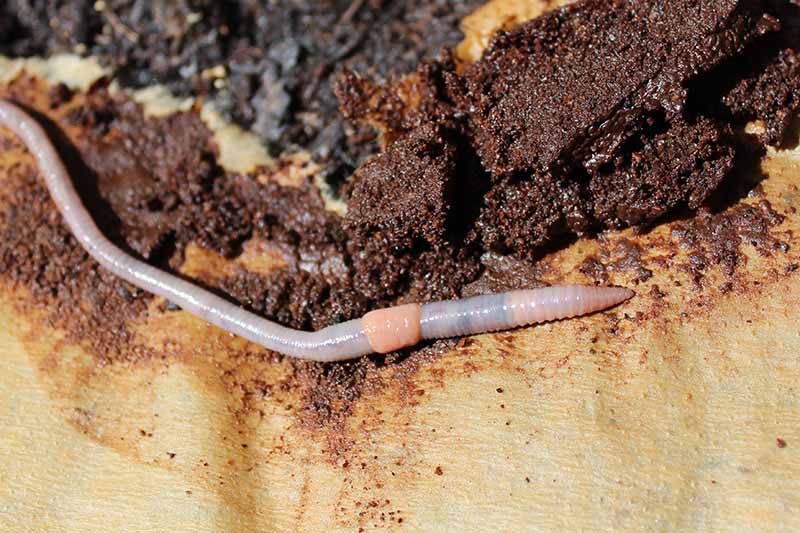
Another study, performed by Ales Hanc and colleagues at the Czech University of Life Sciences in Prague and described in the December 2021 issue of Bioresource Technology, tried using earthworms to break down this food waste, along with the addition of straw pellets.
Hanc and colleagues concluded that a combination of 25 percent spent coffee grounds and 75 percent straw pellets resulted in good numbers and mass of earthworms.
At this proportion, the earthworms were able to break down the caffeine.
So, should you caffeinate your worm bins? If you do, keep the proportion of coffee dregs low, or save them for your regular compost bin – the subject we’re looking into next.
In Compost
As we’ve seen, spent java dregs contain caffeine, a natural antimicrobial. You might be guessing that this is as potentially problematic for our microbial garden partners as it is for our earthworms.
Microbes are the main actors that help break down our yard and food waste and turn it into beautiful compost, after all. We certainly don’t want to kill off these beneficial organisms!
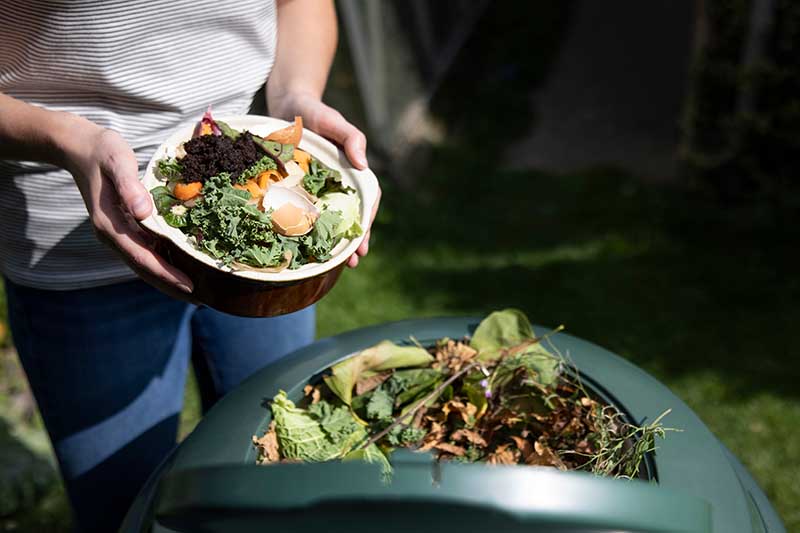
Finally, we have arrived at some good news: If used java grounds are added at the right proportion, they can still be safely included in your pile.
Dr. Linda Chalker-Scott, Extension Urban Horticulturist and Associate Professor at Washington State University Extension, recommends keeping coffee grounds at less than 20 percent of the total volume of your compost pile.
At this percentage, the contents of your pile will still be decomposed by microorganisms, some of which are very good at breaking down caffeine.
The bacteria and fungi in your compost pile will break down that caffeine by the time your compost is ready to mix into your soil – so you won’t have to worry about over-caffeinating your garden beds.

How can you tell if your used coffee grounds are safely below the recommended maximum limit of 20 percent by volume?
I recommend you keep your used grounds in a separate container than your regular tabletop composter, at least while you ascertain your personal household percentage.
Then, when you’re ready for a trip to your outdoor compost bin or heap, compare the contents of both the container holding your used java grounds and the one holding your other kitchen waste.
If you really want to be persnickety about it, you could measure each with measuring cups and then do the math or weigh them out – but eyeballing the two containers will probably be all you need to do.
When you consider yard waste as well, this will further lower the percentage of caffeinated food waste that you added.
So, should you compost your coffee dregs?
I’m going to go out on a limb and guess that the waste from your caffeine habit is probably less than 20 percent of your other compost ingredients, in which case the answer would be a resounding – yes!
If it looks like you produce more caffeinated waste than other kitchen waste, may I be so presumptuous as to introduce you to some fresh fruits and vegetables?
As Mulch
As well as their proposed uses as fertilizer, vermicompost ingredient, and compost addition, spent java grounds are also sometimes promoted as a garden mulch.
Even if we overlook the potential biocidal qualities of caffeine, this use comes with an additional problem.
Have you ever noticed how used espresso dregs keep the shape of the filter basket once they are removed from the filter? That’s because spent coffee grounds have a fine texture – which can easily lead becoming compacted.
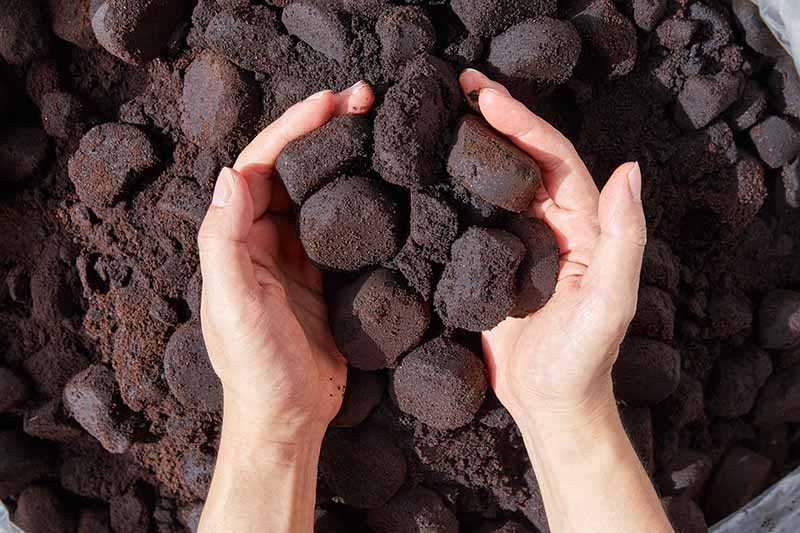
Just as they become compacted in the espresso filter, they can also become compacted on your soil. And hard, compacted soil is the enemy of plant growth.
A compacted layer of mulch would prevent both air and moisture from flowing.
To repurpose this material as a mulch without worrying about compaction, horticulturist Dr. Linda Chalker-Scott recommends using a layer of these dregs that is half an inch thick at most.
This should then be topped with another layer of thicker mulch.
However, to play it safe, choose from one of the many other mulch options available to you, such as fallen leaves.
Nevertheless, why use a biocidal material as a mulch? There may be cases in which you would wish to do so, and that leads us to our final gardening use for coffee dregs.
As Weed and Disease Control
So, we’ve seen that the natural herbicidal and fungicidal properties of coffee can make it problematic when using spent grounds as a soil amendment.
But does that mean that they can actually be used to fight weeds or disease pathogens?
A paper published in the January 2020 issue of Scientia Horticulturae describes the ability of spent coffee grounds to prevent damping off, a disease caused by fungal organisms.
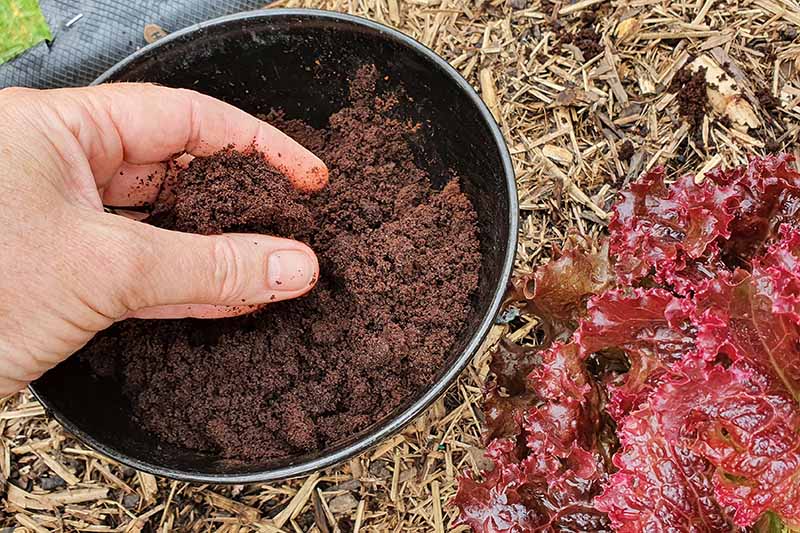
Another experiment, described in volume 60 of the Proceedings of the International Plant Propagators’ Society, led to the conclusion that used coffee grounds made an effective weed suppressant.
However, we currently lack sufficient data on how best to use coffee dregs for disease and weed control without also hurting the plants we wish to protect.
That means gardeners wishing to employ these tactics will simply have to experiment. School science project, anyone?
Make the Most of Your Dark Roast
Thanks to the efforts of these many researchers, home gardeners can take advantage of their scientific findings to safely and efficiently use spent coffee grounds to grow a bounty of food and flowers.
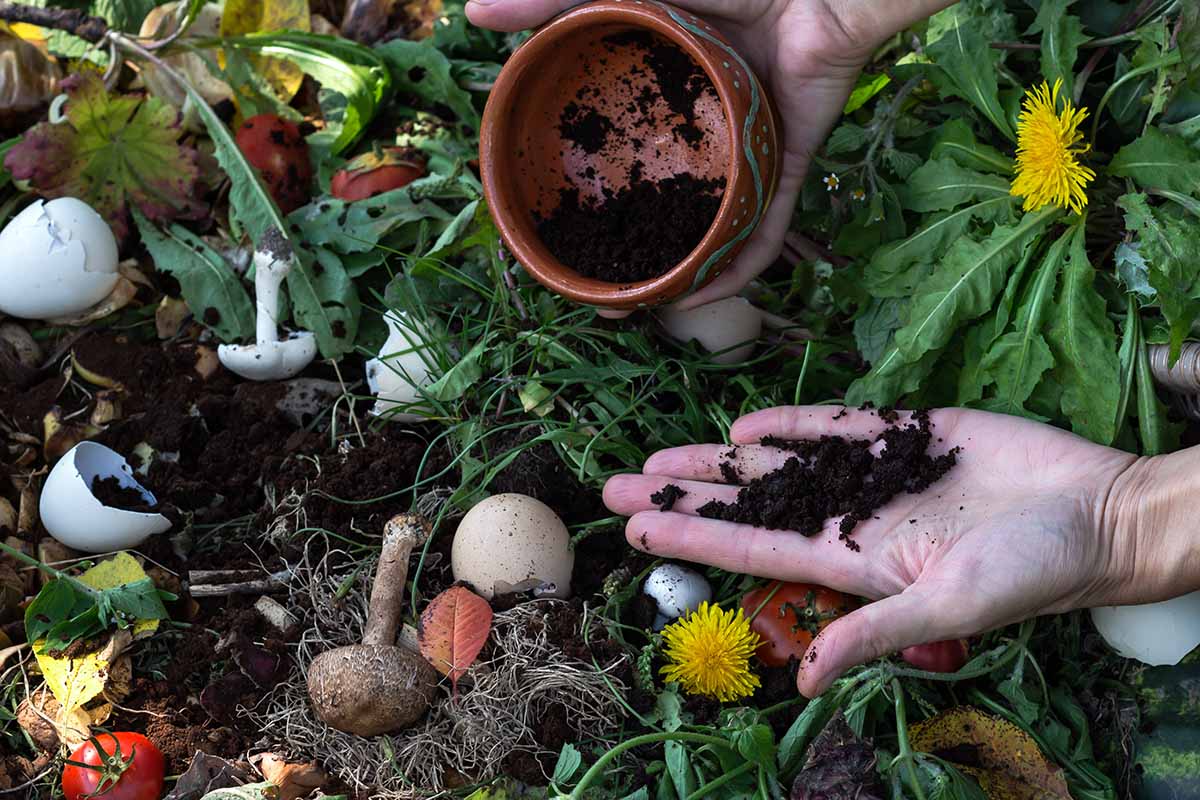
To recap, use your coffee dregs in moderate amounts in your compost or vermicompost, or try it around your plants to prevent weeds, bacteria, and fungal pathogens.
But remember that the caffeine content of your uncomposted dregs can stunt the growth of plants – and might disturb the delicate balance of the soil food web.
Have you been using this food waste product in your own garden? What have your results been? Let us know in the comments section below.
Ready for more composting tips? Check out these other articles next:
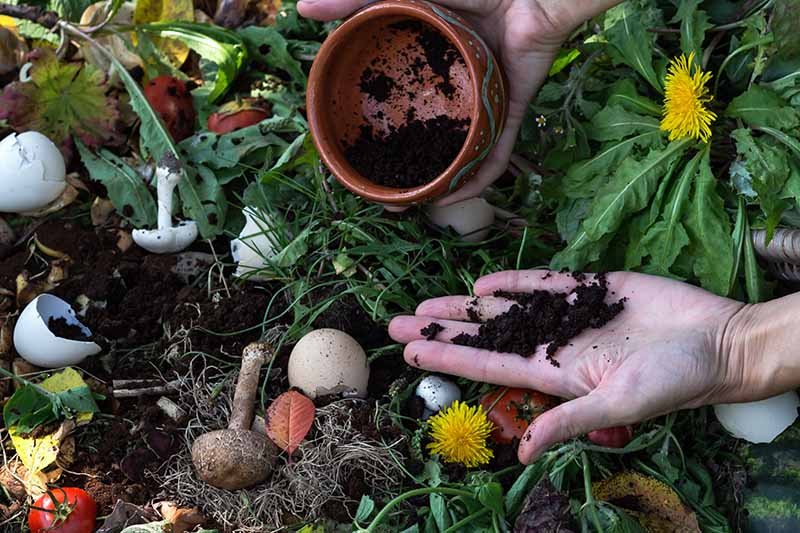
I have a reasonable sized compost pile consisting of 10 bales of wheat straw which I have soaked with water . This morning my wife went to Tims and got about 20 lbs of coffee grounds which I intend to add to my straw compost So if a bale of straw weighs 50 lbs and there are 10 thats 500 lbs That is about 100 lbs of cofee geounds I can add to my compost pile I would welcome your comments pls .As an aside we were the first to ask for coffee grounds they dispose of them by throughing… Read more »
Hi David, Thanks for sharing your coffee-composting situation with us. I love that you are helping to keep these grounds out of the landfill – thank you! So, you were wondering if you were correct that calculating 20% of 500 lbs of straw would allow you to add up to 100 lbs of coffee grounds to your compost pile. Unfortunately the guideline we’re advised to follow is 20% by volume, rather than weight, making this calculation a bit trickier. What you’ll want to do for your scenario is calculate the approximate total volume of your compost pile (or in your… Read more »
Of course, there are a lot of possibilities to use coffee grinds better than disposing of them.
I built an upcycled coffee dryer out of used wood. It dries the coffee grinds within 5 to 12 hours depending on the weather.
The grinds dry only with air without additional energy.
It hangs simply just above the coffee machine on a small nail.
There will be no grinds lost by carrying them trough the house.
Thanks for sharing, Klaus!
I pickup about 50-100 gallons worth of Spent Coffee Grounds monthly from across a couple of the largest Coffee franchise shops as the largest local composter of Coffee grounds and I don’t even drink coffee. It works in the compost if done like the studies listed in the above article. I leave a 5 gallon bucket at each coffee shop that I pickup 3x weekly. I keep a 15 gallon bucket container in the bed of my truck and I swing by the coffee shop, dump the 5 gallon and set it back empty next to the coffee shop back… Read more »
Hi Spencer,
Thanks so much for leaving a comment about your own coffee ground composting endeavors. Your system is an inspiration to me, and I’m sure will be to other readers as well. Happy composting!